Polyethylene Film Surface Modification via Benzoic Acid Grafting
Abstract
1. Introduction
2. Experimental
2.1. Materials
2.2. Grafting Reaction Procedure
2.3. Characterization
2.4. Wettability and Paintability Tests
3. Results and Discussion
4. Conclusions
Author Contributions
Funding
Institutional Review Board Statement
Data Availability Statement
Conflicts of Interest
References
- Narimisa, M.; Ghobeira, R.; Onyshchenko, Y.; Geyter, N.D.; Egghe, T.; Morent, R. Different Techniques Used for Plasma Modification of Polyolefin Surfaces. In Plasma Modification of Polyolefins; Springer: Cham, Switzerland, 2022; pp. 15–56. [Google Scholar]
- Nemani, S.K.; Annavarapu, R.K.; Mohammadian, B.; Raiyan, A.; Heil, J.; Haque, M.A.; Sojoudi, H. Surface modification of polymers: Methods and applications. Adv. Mater. Interfaces 2018, 5, 1801247. [Google Scholar] [CrossRef]
- Mozetič, M. Aging of Plasma-Activated Polyethylene and Hydrophobic Recovery of Polyethylene Polymers. Polymers 2023, 15, 4668. [Google Scholar] [CrossRef] [PubMed]
- Li, T.T.; Cheng, S.B.; Feng, L.F.; Gu, X.P.; Duan, J.T.; Jiang, M.Z.; Zhang, C.L. A review on the free radical grafting of vinyl monomers onto polyethylene and polypropylene by reactive extrusion. Chem. Eng. Sci. 2023, 278, 118916. [Google Scholar] [CrossRef]
- Zhu, J.; Tang, Y.; Lu, L.; Qiu, X.; Pan, L. Reactive extrusion of caffeic acid functionalized ε-polylysine with low-density polyethylene as an antimicrobial and antioxidant film. React. Funct. Polym. 2024, 197, 105861. [Google Scholar] [CrossRef]
- El-Wakil, A.E.A.A.; Moustafa, H.; Youssef, A.M. Antimicrobial low-density polyethylene/low-density polyethylene-grafted acrylic acid biocomposites based on rice bran with tea tree oil for food packaging applications. J. Thermoplast. Compos. Mater. 2022, 35, 938–956. [Google Scholar] [CrossRef]
- Versteeg, F.A.; Benita, B.B.; Jongstra, J.A.; Picchioni, F. Reactive Extrusion Grafting of Glycidyl Methacrylate onto Low-Density and Recycled Polyethylene Using Supercritical Carbon Dioxide. Appl. Sci. 2022, 12, 3022. [Google Scholar] [CrossRef]
- Wei, Z.; Liu, H.; Yu, L.; Xiao, S.; Hou, Y.; Chen, X. Delocalized aromatic molecules with matched electron-donating and electron-withdrawing groups enhancing insulating performance of polyethylene blends. J. Appl. Polym. Sci. 2020, 137, 49185. [Google Scholar] [CrossRef]
- Izdebska-Podsiadły, J.; Thomas, S. (Eds.) Printing on Polymers: Fundamentals and Applications; William Andrew: Chadds Ford, PA, USA, 2015. [Google Scholar]
- Kennedy, J.P.; Maréchal, E. Carbocationic Polymerization; J. Wiley & Sons: New York, NY, USA, 1982. [Google Scholar]
- Carrick, W.L. Reactions of polyolefins with strong lewis acids. J. Polym. Sci. Part A-1 Polym. Chem. 1970, 8, 215–223. [Google Scholar] [CrossRef]
- Díaz, M.F.; Barbosa, S.E.; Capiati, N. J Reactive compatibilization of PE/PS blends. Effect of copolymer chain length on interfacial adhesion and mechanical behavior. Polymer 2007, 48, 1058–1065. [Google Scholar] [CrossRef]
- Grafia, A.L.; Martini, R.E.; Barbosa, S.E. Spray process to styrene grafting onto polyethylene film surface for paintability enhancement. Prog. Org. Coat. 2018, 117, 91–101. [Google Scholar] [CrossRef]
- Martini, R.E.; Brignole, E.A.; Barbosa, S.E. Grafting of styrene onto polyethylene in near critical media. J. Appl. Polym. Sci. 2012, 123, 2787–2799. [Google Scholar] [CrossRef]
- Shriner, R.L.; Hermann, C.K.; Morrill, T.C.; Curtin, D.Y.; Fuson, R.C. The Systematic Identification of Organic Compounds; John Wiley and Sons: New York, NY, USA, 1980. [Google Scholar]
- Żenkiewicz, M. Methods for the calculation of surface free energy of solids. J. Achiev. Mater. Manuf. Eng. 2007, 24, 137–145. [Google Scholar]
- Park, S.J.; Jin, J.S. Effect of corona discharge treatment on the dyeability of low-density polyethylene film. J. Colloid Interface Sci. 2001, 236, 155–160. [Google Scholar] [CrossRef] [PubMed]
- ASTM D3359-02; Standard Test Methods for Measuring Adhesion by Tape Test. ASTM International: West Conshohocken, PA, USA, 2002.
- Gulmine, P.R.; Janissek, P.R.; Heise, H.M.; Akcelrud, L. Polyethylene characterization by FTIR. Polym. Test. 2002, 21, 557–563. [Google Scholar] [CrossRef]
- Abounassif, M.A.; Mian, M.S.; Mian, N.A. Salicylic acid. Anal. Profiles Drug Subst. Excip. 1994, 23, 421–470. [Google Scholar]
- Hayashi, S.; Kimura, N. Infrared Spectra and Molecular Configuration of Benzoic acid. Bull. Inst. Chem. Res. 1966, 44, 335–340. [Google Scholar]
- Indrayanto, G.; Syahrani, A.; Rahman, A.; Tanudjojo, W.; Susanti, S.; Yuwono, M.; Ebel, S. Benzoic acid. In Analytical Profiles of Drug Substances and Excipients; Academic Press: Cambridge, MA, USA, 1999; pp. 1–46. [Google Scholar]
- Guan, X.; Chen, G.; Shang, C. ATR-FTIR and XPS study on the structure of complexes formed upon the adsorption of simple organic acids on aluminum hydroxide. J. Environ. Sci. 2007, 19, 438–443. [Google Scholar] [CrossRef] [PubMed]
- Biber, M.V.; Stumm, W. An In-Situ ATR-FTIR Study: The surface Coordination of Salicylic Acid on Aluminum and Iron (III) Oxides. Environ. Sci. Technol. 1994, 28, 763–768. [Google Scholar] [CrossRef]
- Kubicki, J.D.; Schroeter, L.M.; Itoh, M.J.; Nguyen, B.N.; Apitz, S.E. Attenuated total reflectance Fourier-transform infrared spectroscopy of carboxylic acids adsorbed onto mineral surfaces. Geochem. Cosmochim. Acta 1999, 63, 2709–2725. [Google Scholar] [CrossRef]
- Schultz, J.; Carré, A.; Mazeau, C. Formation and rupture of grafted polyethylene/aluminium interfaces. Int. J. Adhes. Adhes. 1984, 4, 163–168. [Google Scholar] [CrossRef]
- Lewandowski, W.; Baranska, H. The influence of Selected Metals on the Aromatic System of Salicylic Acid. Appl. Spectrosc. 1987, 41, 976–980. [Google Scholar] [CrossRef]
- Groff, R.P. Adsorption and Orientation of Benzoic Acid on Aluminum Oxide: An Infrared Study. J. Od Catal. 1983, 79, 259–263. [Google Scholar] [CrossRef]
- Strälin, A.; Hjertberg, T. Hydrated Aluminum and Polar Groups in Ethylene Copolymers. Surf. Interface Anal. 1993, 20, 337–340. [Google Scholar] [CrossRef]
- Olafsson, G.; Hildingsson, I. Sorption of Fatty Acids into Low-Density Polyethylene and Its Effect on Adhesion with Aluminum Foil in Laminated Packaging Material. J. Agric. Food Chem. 1995, 43, 306–312. [Google Scholar] [CrossRef]
- Olafsson, G.; Hildingsson, I.; Bergnstahl, B. Transport of Oleic and Acetic Acids from Emulsions into Low Density Polyethylene; Effects on Adhesion with Aluminum Foil in Laminated Packaging. J. Food Sci. 1995, 60, 420–425. [Google Scholar] [CrossRef]
- Aoyagi, T.; Araki, T.; Oguni, N.; Mikumo, M.; Tani, H. Synthesis of inuclear organoaluminum compounds containing oxygen, nitrogen, and sulfur atoms. Inorg. Chem. 1973, 12, 2702–2707. [Google Scholar] [CrossRef]
- Guertin, D.L.; Wiberley, S.E.; Bauer, W.H.; Goldenson, J. The infrared spectra of three Aluminum Alkoxides. J. Phys. Chem. 1956, 60, 1018–1019. [Google Scholar] [CrossRef]
- Scott, F.A.; Goldenson, J.; Wiberley, S.E.; Bauer, W.H. Infrared spectra of Aluminum soaps and soaps-hydrocarbon gels. J. Phys. Chem. 1953, 58, 61–64. [Google Scholar] [CrossRef]
- Olafsson, G.; Jägerstad, M.; Öste, R.; Wesslén, B. Effects of different organic acids on the adhesion between polyethylene film and aluminium foil. Food Chem. 1993, 47, 227–233. [Google Scholar] [CrossRef]
- McIntyre, J.F.; Foley, R.T.; Brown, B.F. Infrared spectra of aluminum salt solutions. Appl. Spectrosc. 1982, 36, 128–136. [Google Scholar] [CrossRef]
- Rabek, J.F.; Lucki, J. Crosslinking of polystyrene under friedel–crafts conditions in dichloroethane and carbon tetrachloride solvents through the formation of strongly colored polymer–AlCl3–solvent complexes. J. Polym. Sci. Part A Polym. Chem. 1988, 26, 2537–2551. [Google Scholar] [CrossRef]
- Pretsch, E.; Clerc, T.; Seibl, J.; Simon, W. Tables of Spectral Data for Structure Determination of Organic Compounds; Springer Science & Business Media: New York, NY, USA, 2013. [Google Scholar]
- Thomas, C.A. Anhydrous AlCl3 in Organic Chemistry; Reinhold: New York, NY, USA, 1941; p. 716. [Google Scholar]
- Phambu, N. Adsorption of carboxylic acids on submicrocrystalline aluminum hydroxides in aqueous solution. Part I: Qualitative study by infrared and Raman spectroscopy. Appl. Spectrosc. 2002, 56, 756–761. [Google Scholar] [CrossRef]
- Pękal, A.; Pyrzynska, K. Evaluation of aluminium complexation reaction for flavonoid content assay. Food Anal. Methods 2014, 7, 1776–1782. [Google Scholar] [CrossRef]
- Yokel, R.A.; Wilson, M.; Harris, W.R.; Halestrap, A.P. Aluminum citrate uptake by immortalized brain endothelial cells: Implications for its blood–brain barrier transport. Brain Res. 2002, 930, 101–110. [Google Scholar] [CrossRef] [PubMed]
- Karlik, S.J.; Tarien, E.; Elgavish, G.A.; Eichhorn, G.L. Aluminum-27 nuclear magnetic resonance study of aluminum (III) interactions with carboxylate ligands. Inorg. Chem. 1983, 22, 525–529. [Google Scholar] [CrossRef]
- Motekaitis, R.J.; Martell, A.E. Complexes of aluminum (III) with hydroxy carboxylic acids. Inorg. Chem. 1984, 23, 18–23. [Google Scholar] [CrossRef]
- Xin, X.; Si, W.; Yao, Z.; Feng, R.; Du, B.; Yan, L.; Wei, Q. Adsorption of benzoic acid from aqueous solution by three kinds of modified bentonites. J. Colloid Interface Sci. 2011, 359, 499–504. [Google Scholar] [CrossRef] [PubMed]
- Yariv, S.; Cross, H. Organo-Clay Complexes and Interactions; The Clay Minerals Society: New York, NY, USA, 2002. [Google Scholar]
- Niwa, M.; Inagaki, S.; Murakami, Y. Alumina: Sites and mechanism for benzaldehyde and ammonia reaction. J. Phys. Chem. 1985, 89, 2550–2555. [Google Scholar] [CrossRef]
- Almond, J.; Sugumaar, P.; Wenzel, M.N.; Hill, G.; Wallis, C. Determination of the carbonyl index of polyethylene and polypropylene using specified area under band methodology with ATR-FTIR spectroscopy. e-Polymers 2020, 20, 369–381. [Google Scholar] [CrossRef]
- Anderson, D.A.; Freeman, E.S. The kinetics of the thermal degradation of polystyrene and polyethylene. J. Polym. Sci. 1961, 54, 253–260. [Google Scholar] [CrossRef]
- Peterson, J.D.; Vyazovkin, S.; Wight, C.A. Kinetics of the thermal and thermo-oxidative degradation of polystyrene, polyethylene and poly (propylene). Macromol. Chem. Phys. 2001, 202, 775–784. [Google Scholar] [CrossRef]
- Fuzail, M.; Shah, G.; Anwar, J. Modification of polyethylene and incorporation of Al (OH) 3 for improvement of mechanical properties, burning behaviour and thermal stability. Iran. Polym. J. 2010, 19, 47–56. [Google Scholar]
- Wilkie, C.A.; Morgan, A.B. Fire Retardancy of Polymeric Materials; CRC Press: New York, NY, USA, 2009. [Google Scholar]
- Dwiasi, D.W.; Mudasir, M.; Roto, R. Ion exchange of benzoate in Ni-Al-benzoate layered double hydroxide by amoxicillin. Open Chem. J. 2019, 17, 1043–1049. [Google Scholar] [CrossRef]
- Hartman, M.; Trnka, O.; Šolcová, O. Thermal decomposition of aluminum chloride hexahydrate. Ind. Eng. Chem. Res. 2005, 44, 6591–6598. [Google Scholar] [CrossRef]
- Aliev, R. Hydrophilicity and surface energy of polyethylene modified by radiation grafting of acrylamide. Polym. Bull. 2001, 47, 99–104. [Google Scholar] [CrossRef]
- De Geyter, N.; Morent, R.; Leys, C. Surface characterization of plasma-modified polyethylene by contact angle experiments and ATR-FTIR spectroscopy. Surf. Interface Anal. Int. J. Devoted Dev. Appl. Tech. Anal. Surf. Interfaces Thin Film. 2008, 40, 608–611. [Google Scholar] [CrossRef]
- Jańczuk, B.; Białlopiotrowicz, T. Surface free-energy components of liquids and low energy solids and contact angles. J. Colloid Interface Sci. 1989, 127, 189–204. [Google Scholar] [CrossRef]
- Seyhan, A.; Gunaydin, B.N.; Polat, Y.; Kilic, A.; Demir, A.; Avci, H. Improvement of polyethylene fiber wettability and mechanical properties through an environmentally sustainable spinning process. Int. J. Adhes. Adhes. 2022, 119, 103250. [Google Scholar] [CrossRef]
- Subedi, D.P. Contact angle measurement for the surface characterization of solids. Himal. Phys. 2011, 2, 1–4. [Google Scholar] [CrossRef]
- Bekele, S.; Tsige, M. Interfacial properties of oxidized polystyrene and its interaction with water. Langmuir 2013, 29, 13230–13238. [Google Scholar] [CrossRef]
- Brown, P.S.; Bhushan, B. Mechanically durable liquid-impregnated honeycomb surfaces. Sci. Rep. 2017, 7, 6083. [Google Scholar] [CrossRef]
- Strobel, M.; Kirk, S.M.; Heinzen, L.; Mischke, E.; Lyons, C.S.; Endle, J.; Dillingham, G. Contact angle measurements on oxidized polymer surfaces containing water-soluble species. J. Adhes. Sci. Technol. 2015, 29, 1483–1507. [Google Scholar] [CrossRef]
- Zdziennicka, A.; Szymczyk, K.; Krawczyk, J.; Jańczuk, B. Some remarks on the solid surface tension determination from contact angle measurements. Appl. Surf. Sci. 2017, 405, 88–101. [Google Scholar] [CrossRef]
- Rytlewski, P.; Żenkiewicz, M. Laser-induced surface modification of polystyrene. Appl. Surf. Sci. 2009, 256, 857–861. [Google Scholar] [CrossRef]
- Florjanczyk, Z.; Bury, W.; Zygadło-Monikowska, E.; Justyniak, I.; Balawender, R.; Lewinski, J. Structure Investigations of Dichloroaluminum Benzoates: An Unprecedented Example of a Monomeric Aluminum Complex with a Chelating Carboxylate Ligand. Inorg. Chem. 2009, 48, 10892–10894. [Google Scholar] [CrossRef] [PubMed]
- Ataeefard, M. Study of PLA printability with flexography ink: Comparison with common packaging polymer. Prog. Color Color. Coat. 2019, 12, 101–105. [Google Scholar]
- Derbyshire, A.N.; Mills, W.P.; Shore, J. The role of auxiliary products in the high–temperature dyeing of polyester. J. Soc. Dye. Colour. 1972, 88, 389–394. [Google Scholar] [CrossRef]
- Roberts, G.A.F.; Solanki, R.K. Carrier Dyeing of Polyester Fibre: Part I–Studies of Carrier Diffusion. J. Soc. Dye. Colour. 1979, 95, 226–229. [Google Scholar] [CrossRef]
- Ye, H.; Xie, Z.; Li, W.; Pu, Y.; Liu, M.; Wen, Y.; Liu, Y. Converting waste polystyrene foam into new value-added materials: A large-capacity scavenger to remove cationic dyes and heavy metals. J. Appl. Polym. Sci. 2022, 139, 51868. [Google Scholar] [CrossRef]
- Aydemir, C.; Altay, B.N.; Akyol, M. Surface analysis of polymer films for wettability and ink adhesion. Color Res. Appl. 2021, 46, 489–499. [Google Scholar] [CrossRef]



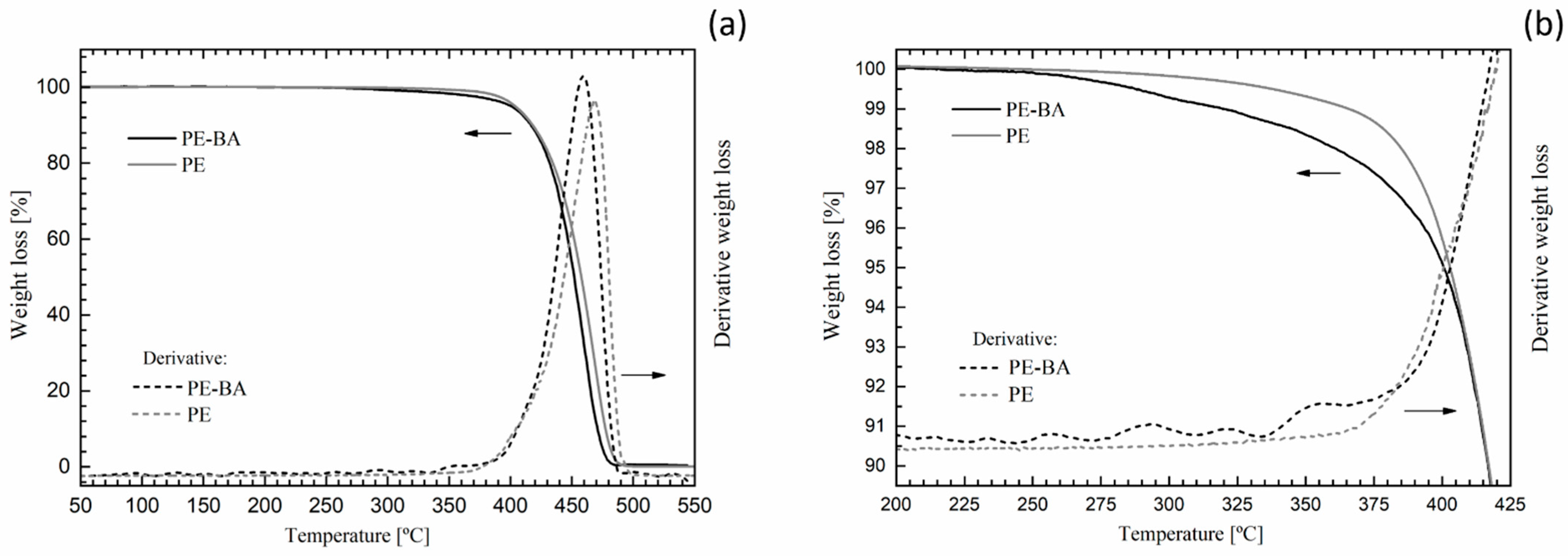
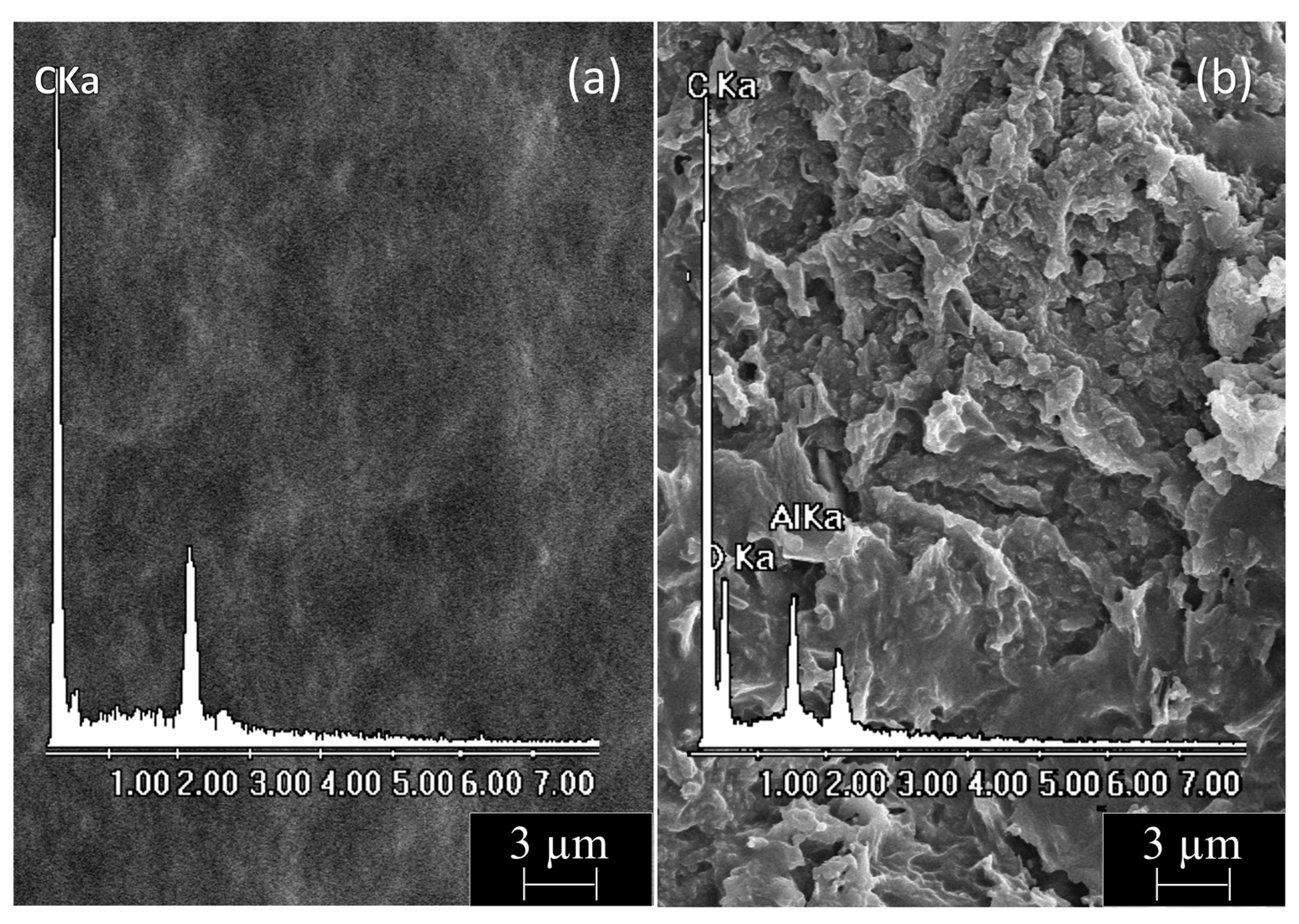

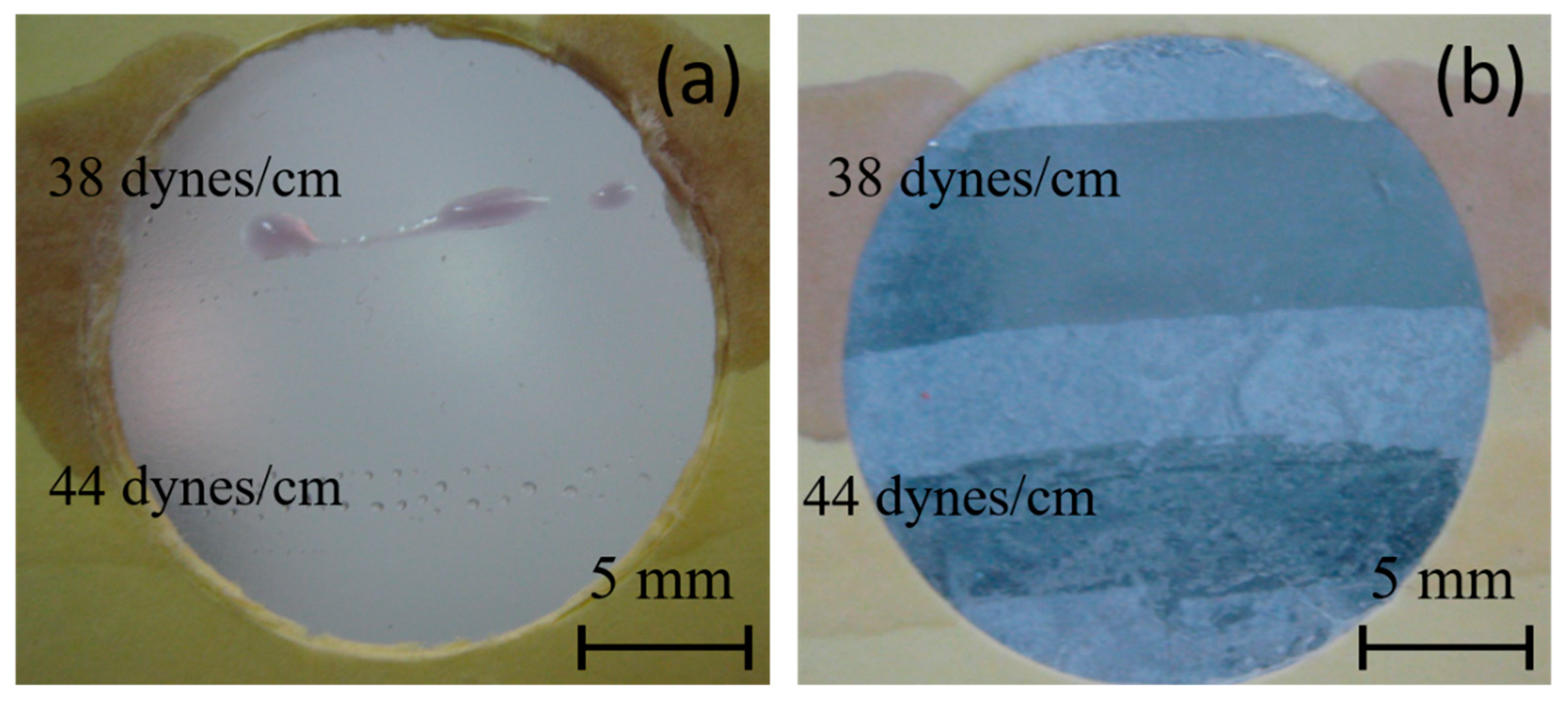
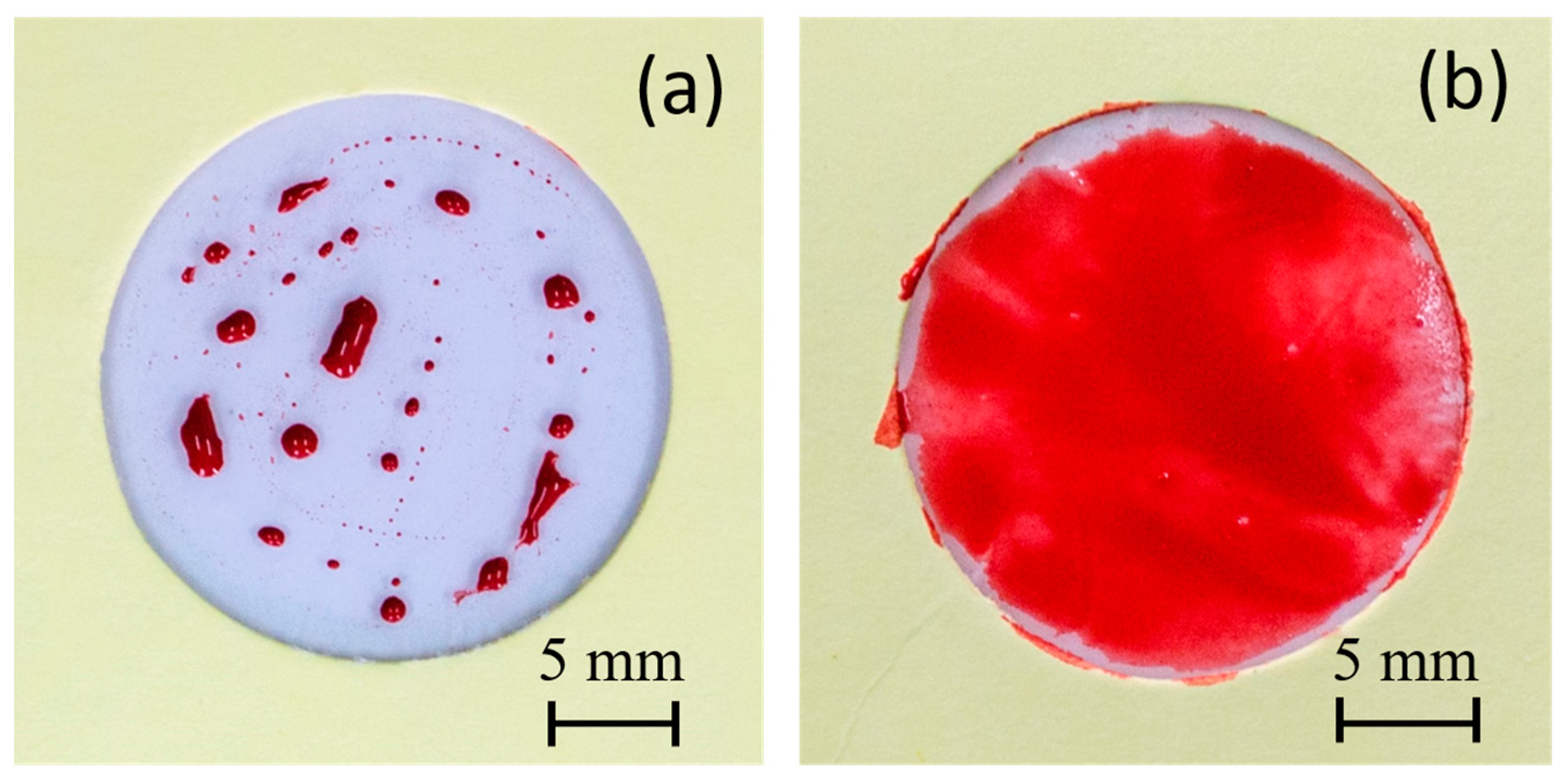
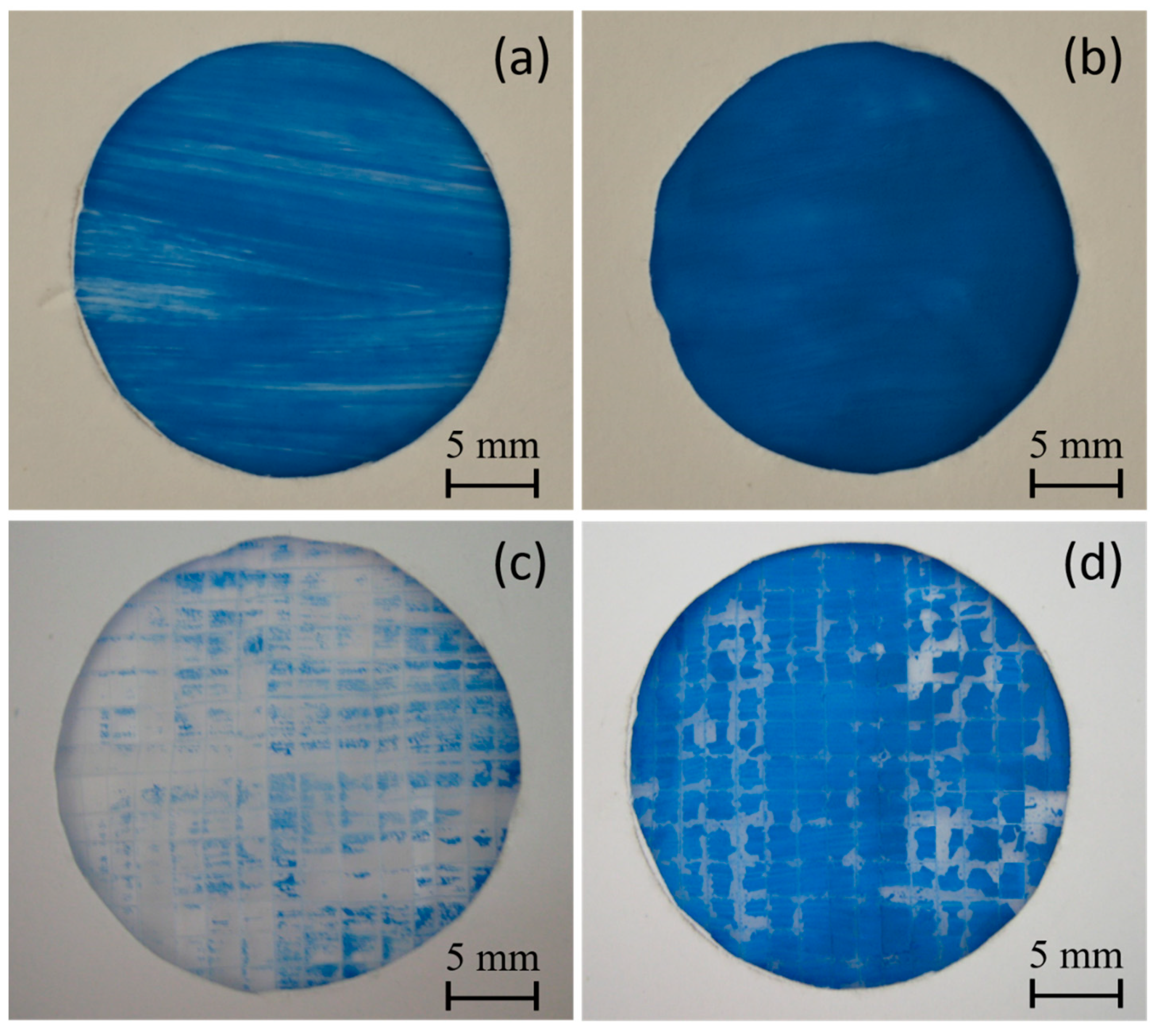
| Liquid | [mJ. m−2] | [mJ. m−2] | [mJ. m−2] |
|---|---|---|---|
| water | 21.8 | 51.0 | 72.8 |
| diiodomethane | 50.42 | 0.38 | 35.00 |
| Frequency [cm−1] | Assignment | References | ||
|---|---|---|---|---|
| PE-BA | PE | BA | ||
| 1685 | C=O free carboxylic acid stretching mode | [20,21] | ||
| 1641 | C=O stretching vibration, in monodentate aluminum benzoate complexes (1645 cm−1). | [23] | ||
| 1619 1571 1440 1317 | Vibrations related to monodentate aluminum benzoates complexes (1622 cm−1, 1571 cm−1, 1440 cm−1, 1317 cm−1) | [24,25,26] | ||
| 1605 1566 1433 | C-O in bridge or bidentate complexes | [23,27] | ||
| 1506 1540 | -COO− benzoate ion (1550 cm−1) and oriented benzoate on aluminum oxide (1500 cm−1) | [28] | ||
| 1521 1405 | -COO−Al+ aluminum carboxylate (1523–1410 cm−1) | [29] | ||
| 1496 | 1496 | C-C of aromatic ring | [20,21,22] | |
| 1472 1462 | 1472 1462 | CH bending deformation | [19] | |
| 1397 | -COO− carboxylate ion on aluminum surface | [30,31] | ||
| 1378 | 1378 | CH3 symmetric deformation | [19] | |
| 1306 | 1306 | CH3 twisting deformation | [19] | |
| 1326 1292 | C-O of COOH-coupled stretching vibrations | [21] | ||
| 1270 | CH2-Al | [32] | ||
| 1179 1069 | Al-O-C | [33] | ||
| 1003 990 | Al-O | [30,34] | ||
| 721 719 | 721 719 | CH2 rocking deformation | [19] | |
| Salt | Monodentate Complexes | Bidentate Complexes | |
|---|---|---|---|
| Mononuclear | Binuclear | ||
| Chelate | Bridge | ||
| Aluminum benzoates |  |  |  |
| Sample | Water Contact Angle [°] | Diiodomethane Contact Angle [°] | Surface Energy [mJ. m−2] | ||
|---|---|---|---|---|---|
| PE | 95 ± 2 | 52 ± 1 | 31.71 | 0.95 | 32.71 |
| PE-BA | 84 ± 3 | 51 ± 2 | 30.97 | 4.04 | 35.00 |
Disclaimer/Publisher’s Note: The statements, opinions and data contained in all publications are solely those of the individual author(s) and contributor(s) and not of MDPI and/or the editor(s). MDPI and/or the editor(s) disclaim responsibility for any injury to people or property resulting from any ideas, methods, instructions or products referred to in the content. |
© 2024 by the authors. Licensee MDPI, Basel, Switzerland. This article is an open access article distributed under the terms and conditions of the Creative Commons Attribution (CC BY) license (https://creativecommons.org/licenses/by/4.0/).
Share and Cite
Grafia, A.L.; Barbosa, S.E. Polyethylene Film Surface Modification via Benzoic Acid Grafting. Polymers 2024, 16, 1291. https://doi.org/10.3390/polym16091291
Grafia AL, Barbosa SE. Polyethylene Film Surface Modification via Benzoic Acid Grafting. Polymers. 2024; 16(9):1291. https://doi.org/10.3390/polym16091291
Chicago/Turabian StyleGrafia, Ana Luisa, and Silvia Elena Barbosa. 2024. "Polyethylene Film Surface Modification via Benzoic Acid Grafting" Polymers 16, no. 9: 1291. https://doi.org/10.3390/polym16091291
APA StyleGrafia, A. L., & Barbosa, S. E. (2024). Polyethylene Film Surface Modification via Benzoic Acid Grafting. Polymers, 16(9), 1291. https://doi.org/10.3390/polym16091291






